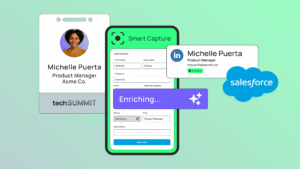
If you’ve ever wrapped up an event and thought, “That went well… I think?” you’re not alone. Too often, event planning becomes a cycle of logistics, deadlines, and checklists, only to end with little clarity on what the event actually achieved.
The room may have felt full, but was it worth the time, budget, and effort?
Without clear event goals, it’s almost impossible to prove ROI or know if your event made a real impact. The good news? You don’t need a massive overhaul. The first step is simple: set measurable, outcome-based goals that act as a bridge between effort and impact.
Why Event Goals Matter
Clear, measurable event goals transform events from one-off logistics into strategic levers for growth. They:
- Provide clarity on why the event exists and what success looks like.
- Align cross-functional teams (admissions + advancement, fundraising + programs, marketing + sales).
- Enable you to prove ROI and secure future investment.
As Nancy Huemer, Director of Special Events at Barnard College, shared in a recent webinar:
“Gone are the days of doing things just because that’s how we’ve always done them.”
Her team shifted from routine planning to goal-driven strategy and saw significant results. Here’s what changed at Barnard when the team began setting clearer goals:
- Reliable attendance tracking in Salesforce enabled year-over-year trend reporting (e.g., lower 15-year reunion vs. stronger 50-year), so they shifted time and budget to the events that perform.
- Targeted invitations for a major center opening re-engaged lapsed donors, resulting in new gifts.
- A “Prospects Attending” live dashboard let fundraisers self-serve in real time, reducing ad-hoc email requests and speeding follow-up.
- Shared reports and executive dashboards gave leadership clear visibility and greater confidence in event impact.
- On-site badge scans + attendance data fueled personalized outreach, deepening relationships after the event.
Event goals give your team clarity, focus, and the ability to measure outcomes. Whether you’re hosting yield events or corporate events, setting event goals is what connects effort to impact.
Why Event Success Metrics Often Fall Short (And How to Fix Them)
Barnard’s experience shows what’s possible when event goals are clear and measurable. But without that clarity, many teams end up with the opposite outcome:
- Working in silos — departments chase their own priorities without a shared definition of success.
- Struggling to show ROI — events feel busy but lack proof of real impact.
- Missing critical insights — teams repeat events without knowing what worked, what didn’t, or what to change next.
So why do so many event success metrics fall short? In most cases, it comes down to three root causes:
- They’re too vague. “Have a successful event” or “drive engagement” are common goals, but they’re not measurable.
- They’re not shared across departments. If advancement is measuring donations while admissions is focused on applications, the event can’t be evaluated holistically.
- They’re not connected to systems that track results. Too many teams still rely on spreadsheets or manual counts, which makes year-over-year comparisons and lifecycle tracking nearly impossible.
How to fix it:
- Define success together. Bring in stakeholders early to align on what matters most, then write it down and revisit it post-event.
- Set SMART goals. Specific, measurable, attainable, relevant, and time-bound goals keep “success” from being open to interpretation.
- Track consistently. Use one template (or better yet, a CRM like Salesforce) for every event to capture registrations, attendance, engagement, and follow-up actions. Consistency makes trend analysis and improvement possible.
When event goals are specific, shared, and backed by data, they stop being abstract and start shaping strategy. That’s where SMART goals come in.
What Are SMART Event Goals?
SMART goals provide a clear framework for defining success:
- Specific: Clearly defined and outcome-focused
- Measurable: Tracked with metrics like attendance, engagement, or post-event action
- Attainable: Ambitious but realistic
- Relevant: Tied to your institution or organization’s broader objectives
- Time-bound: Set to a timeline
With SMART goals, “success” is no longer open to interpretation. It’s measurable and actionable. Now, let’s look at some examples of effective SMART event goals.
Examples of Effective SMART Event KPIs
Not every event has the same purpose. A recruitment fair, donor dinner, or product roadshow should each be measured against the outcomes that matter most for that audience and stage of the journey.
The key is to tie every goal back to a measurable outcome that stakeholders across the institution or organization agree on. That transforms events from “just another task” into a strategic growth driver.
As Meghan Toth, Director of Prospect Research at Barnard College, put it:
“If we don’t agree on what the goals are for the event, what matters to our office, then we end up working in silos.”
Her point underscores why SMART goals matter: they provide the shared focus that keeps teams aligned and accountable.
Here’s a more detailed framework on how to think about setting goals:
Top-of-Funnel Goals
At this stage, your audience is just getting to know you. Goals here should focus on reach, awareness, and engagement.
Build brand awareness
Example: Increase new registrations by 20% compared to the previous year.
Why it matters: Expands your pool of potential students, donors, or customers.
How to measure: Registrations from new contacts, social shares, referral traffic.
Establish thought leadership
Example: Boost content downloads during the event by 15%.
Why it matters: Positions your institution or organization as a credible leader.
How to measure: Whitepaper or resource downloads, session attendance numbers.
Drive attendee engagement
Example: Achieve at least 100 poll responses or 50 chat interactions per session.
Why it matters: Active participation signals interest and improves retention.
How to measure: Poll and chat analytics, session duration per attendee.
Middle-of-Funnel Goals
Here, your audience is evaluating options and looking for deeper value. Goals should connect engagement to pipeline or relationship-building.
Advance leads from MQLs to SQLs
Example: Track how many attendees request a meeting within two weeks post-event.
Why it matters: Shows the event’s role in moving people closer to a decision.
How to measure: CRM activity logs, follow-up meeting counts.
Increase demo conversions
Example: Secure demo requests from at least 10% of attendees.
Why it matters: Demonstrates that the event generated serious buying intent.
How to measure: Demo sign-ups linked back to the event campaign.
Enable personalized follow-up
Example: Use attendee engagement data (sessions attended, questions asked) to segment follow-up campaigns.
Why it matters: Tailored outreach increases relevance and response rates.
How to measure: Follow-up email open/click rates, conversion by segment.
Bottom-of-Funnel Goals
This stage is about proving value and securing tangible outcomes. Goals should focus on ROI, conversion, and experience.
Generate closed-won revenue
Example: Attribute at least $100K in pipeline or revenue to event attendees.
Why it matters: Connects the event directly to financial impact.
How to measure: CRM attribution reports, revenue influenced by event contacts.
Achieve ROI per event
Example: Deliver a minimum 3:1 return (revenue vs. cost).
Why it matters: Justifies the budget and informs future investment.
How to measure: Compare event costs with attributed revenue.
Improve attendee experience
Example: Increase Net Promoter Score (NPS) by 10 points compared to last year.
Why it matters: A positive attendee experience drives loyalty and retention.
How to measure: Post-event surveys, repeat attendance rates.
Start Measuring Event Success
The good news: you don’t need a massive overhaul to start seeing impact. A few deliberate steps can transform how your team approaches events:
- Set one SMART goal for your next event and tie it to a mission-level outcome.
- Align with stakeholders early. Write the goal down, agree on how success will be measured, and revisit it after the event.
- Decide how you’ll track progress upfront. Whether it’s a simple spreadsheet or a Salesforce dashboard, put a process in place before the event so you’re ready to measure what matters afterward.
Want to see what SMART event goals look like in practice? Watch the on-demand webinar with Barnard College: Why Event Planners Should Care About CRM Strategy. You’ll walk away with practical ideas any event planner—higher ed, corporate, nonprofit, or beyond—can use today.
Ready to stop juggling tools and start running smarter events?
Schedule a demo and see how Blackthorn works inside Salesforce.


